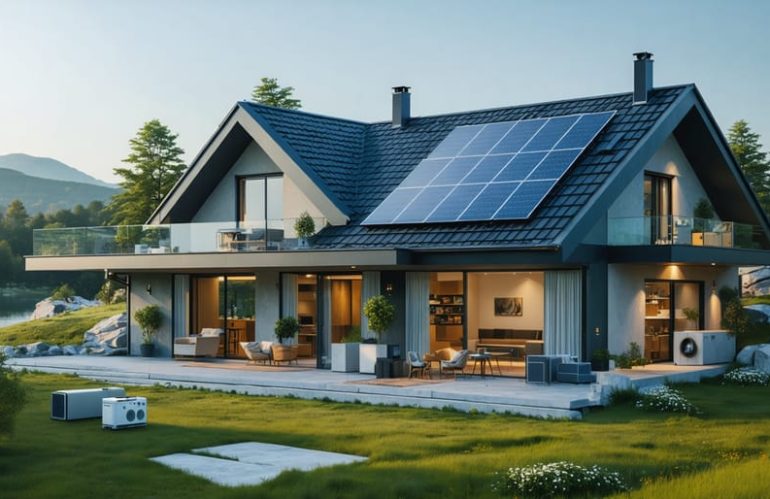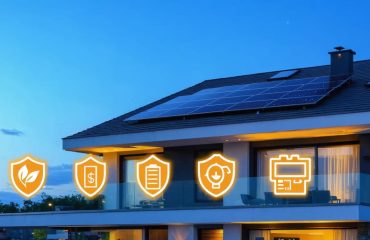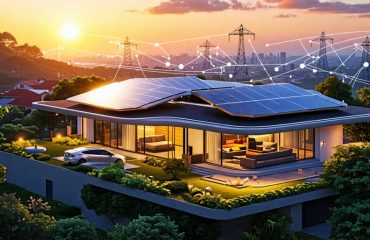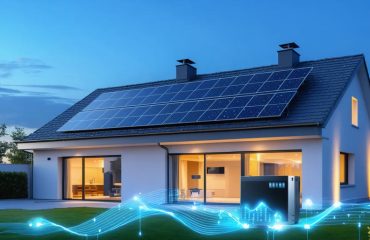Transform your home into a self-sustaining energy hub with an off-grid solar system that powers your lifestyle while eliminating utility bills. Modern high-performance solar system design has made energy independence more achievable than ever, combining advanced battery storage, efficient panels, and smart power management to deliver reliable electricity 24/7.
Unlike traditional grid-tied setups, off-grid systems offer complete energy autonomy, protecting you from power outages and rising electricity costs. Whether you’re building a remote cabin or seeking to disconnect your existing home from the grid, today’s solar technology provides a proven path to sustainable, independent living.
This comprehensive guide walks you through essential components, sizing considerations, and real-world maintenance requirements, helping you create a robust solar solution tailored to your specific energy needs. From selecting the right battery bank to optimizing panel placement, you’ll discover how to build a system that delivers decades of reliable, clean energy while maximizing your investment.
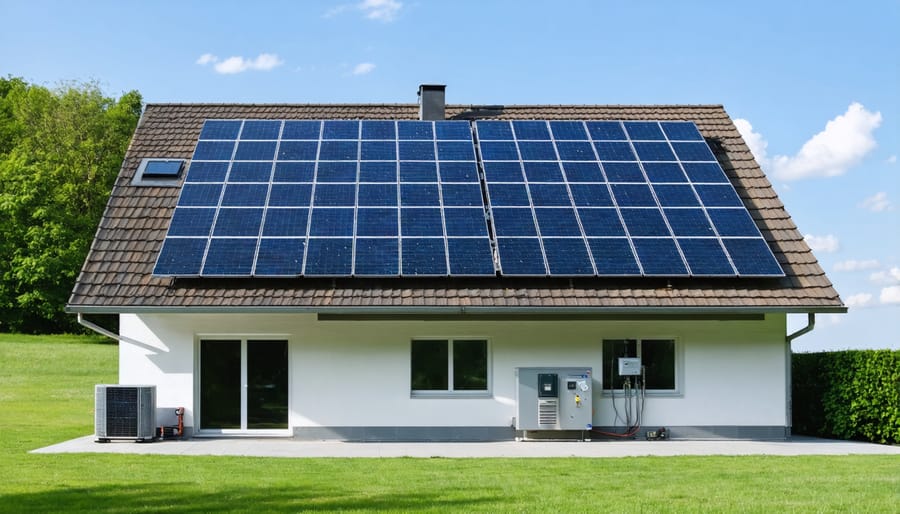
Essential Components of an Off-Grid Solar System
Solar Panels and Array Design
Selecting the right solar panels and designing your array is crucial for achieving optimal panel performance in your off-grid system. Modern solar panels come in two main types: monocrystalline and polycrystalline. Monocrystalline panels offer higher efficiency and take up less space, making them ideal for homes with limited roof area. Polycrystalline panels, while slightly less efficient, provide excellent value for larger installations.
When sizing your array, consider your daily energy consumption and local weather patterns. A good rule of thumb is to add 20% extra capacity to account for cloudy days and seasonal variations. For most off-grid homes, an array between 5kW and 12kW is typical, depending on energy needs and lifestyle.
Panel placement is equally important. South-facing installations (in the Northern Hemisphere) typically generate the most power, with a tilt angle matching your latitude for year-round performance. Avoid shade from trees or buildings, as even partial shade can significantly reduce energy production. Consider mounting options like roof installations or ground-mounted arrays based on your property’s layout and available space.
Battery Storage Solutions
Battery storage is the heart of any off-grid solar system, ensuring you have power when the sun isn’t shining. Most modern homes rely on lithium-ion batteries, which offer excellent performance and longevity compared to traditional lead-acid options. A typical off-grid home requires 10-15 kWh of battery storage capacity to maintain reliable power through the night and cloudy days.
When planning your battery storage, consider your daily energy consumption and add a 20% buffer for unexpected needs. Lithium iron phosphate (LiFePO4) batteries are particularly popular for their safety features and 10+ year lifespan. While they cost more upfront, their longer life and better performance make them a smart investment.
To maximize battery life, install a battery management system (BMS) that prevents over-charging and deep discharging. Consider seasonal variations in your planning – you’ll need more storage capacity during winter months when there’s less sunlight. Many homeowners also include a backup generator for additional peace of mind during extended periods of low solar production.
Temperature-controlled storage spaces help extend battery life, as extreme temperatures can affect performance and longevity. Regular monitoring of battery health through your system’s interface ensures optimal performance and helps predict when maintenance might be needed.
Inverters and Charge Controllers
Inverters and charge controllers are essential components that ensure your off-grid solar system runs smoothly and efficiently. The inverter converts DC power from your solar panels and batteries into AC power that your home appliances can use. Most modern inverters are “pure sine wave” models, offering reliable power that’s identical to grid electricity.
Charge controllers act as traffic cops for your system, regulating the flow of electricity from your solar panels to your batteries. They prevent overcharging and extend battery life by maintaining optimal charging conditions. MPPT (Maximum Power Point Tracking) controllers are particularly efficient, capturing up to 30% more power than standard models.
When selecting these components, choose equipment sized appropriately for your power needs, with room for future expansion. Quality matters – investing in reliable inverters and controllers helps prevent system failures and ensures consistent power delivery.
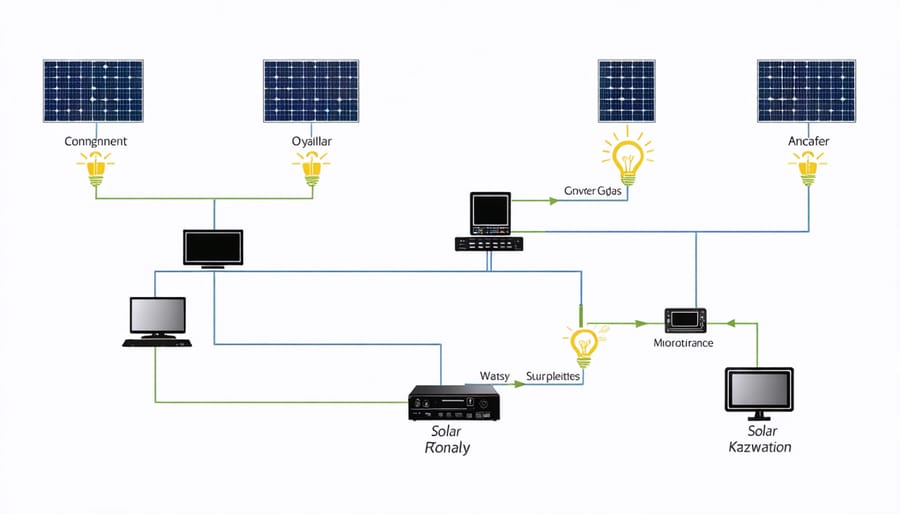
Designing Your System for Maximum Resilience
Load Calculation and System Sizing
Calculating your home’s energy needs is the crucial first step in designing an effective off-grid solar system. Start by creating a detailed list of all your electrical appliances and devices, including their wattage ratings. Most appliances have this information on their labels or in their manuals.
Next, estimate how many hours each device runs daily. Multiply the wattage by hours of use to determine daily watt-hours. For example, a 60-watt light bulb used for 5 hours consumes 300 watt-hours per day. Add up all these calculations to find your total daily energy consumption.
Remember to account for seasonal variations – you’ll likely use more energy during winter months for heating or summer months for cooling. It’s wise to add a 20% buffer to your calculations to accommodate unexpected usage spikes and system inefficiencies.
Consider energy-efficient alternatives before finalizing your calculations. LED lights, energy-star appliances, and smart power strips can significantly reduce your overall energy needs, leading to a smaller, more affordable solar system.
Key appliances to include in your calculations:
– Refrigerator and freezer
– HVAC systems
– Water heater
– Lighting
– Kitchen appliances
– Entertainment systems
– Well pump (if applicable)
Keep a detailed energy consumption log for at least a week to ensure your calculations reflect real-world usage patterns. This information will be invaluable when working with solar installers to design your perfect system.
Backup Power Integration
A reliable backup power system is essential for any off-grid solar setup. While your solar panels work hard during the day, having a secondary power source ensures continuous electricity even during extended cloudy periods or unexpected system maintenance.
Generator integration is the most common backup solution, with propane generators being particularly popular due to their fuel’s long shelf life and clean-burning properties. A quality automatic transfer switch seamlessly transitions between your solar system and backup power when needed, eliminating disruption to your power supply.
For enhanced reliability, consider implementing a hybrid approach combining multiple backup sources. This might include a smaller portable gas generator for emergencies alongside your main backup system. Battery redundancy is another crucial consideration – installing additional battery capacity beyond your basic needs provides a safety buffer during challenging weather conditions.
Many homeowners also incorporate a dedicated critical loads panel, which ensures essential appliances and systems remain powered even when conserving energy. This strategic approach to backup power helps maintain comfort and security while maximizing system efficiency.
Weather-Proofing Strategies
Protecting your off-grid solar system from weather challenges is crucial for maintaining reliable power generation year-round. Start by ensuring a storm-proof solar installation that includes robust mounting systems and high-quality weatherproof components. Position panels at the optimal angle to shed snow and debris naturally, typically between 30-45 degrees.
Install lightning protection systems, including proper grounding equipment and surge protectors, to safeguard your investment during electrical storms. Consider protective covers for battery banks and inverters, ensuring proper ventilation while keeping moisture at bay. In areas prone to high winds, reinforce mounting structures and use wind deflectors where necessary.
Regular maintenance plays a key role in weather-proofing. Clear debris after storms, check seals and connections quarterly, and apply weather-resistant coatings to exposed components annually. Installing monitoring systems helps detect weather-related issues early, allowing for quick intervention before problems escalate. These preventive measures ensure your system continues performing efficiently regardless of weather conditions.
Maintenance and Monitoring
Regular Maintenance Schedule
Regular maintenance is crucial for keeping your off-grid solar system running efficiently. While solar systems are generally low-maintenance, following a consistent schedule helps prevent issues and extends system life, especially when facing various climate challenges for solar systems.
Monthly Tasks:
– Check battery water levels (for flooded lead-acid batteries)
– Clean solar panels with water and a soft brush
– Monitor system performance through your charge controller
– Inspect wiring connections for signs of wear
Quarterly Tasks:
– Test battery voltage under load
– Clear debris and vegetation around ground-mounted panels
– Check mounting hardware for tightness
– Clean ventilation systems around batteries and inverters
Annual Tasks:
– Professional inspection of electrical connections
– Battery capacity testing
– Inverter efficiency check
– Solar panel efficiency assessment
– Replacement of any worn components
Most maintenance tasks are simple enough for homeowners to handle, though it’s recommended to have a professional inspection once a year. Keep a maintenance log to track performance and identify potential issues early. Remember that well-maintained systems typically last 25-30 years, making your investment in regular upkeep worthwhile for long-term energy independence.
System Monitoring Solutions
Modern off-grid solar systems come with sophisticated monitoring solutions that make it easy to track your system’s performance and energy usage. Most inverters now include built-in monitoring capabilities accessible through smartphone apps or web portals, allowing you to check your system’s output in real-time from anywhere.
These monitoring tools typically display essential metrics like daily power generation, battery charge levels, and energy consumption patterns. You can view detailed graphs showing peak production times and identify any unusual drops in performance that might indicate maintenance needs.
Some popular monitoring features include:
– Real-time power flow visualization
– Historical performance data
– Battery state of charge
– Energy consumption trends
– Weather integration
– System alerts and notifications
Smart monitoring systems can also help optimize your energy usage by showing you the best times to run power-hungry appliances based on solar production and battery levels. Many systems will send automatic alerts if they detect potential issues, helping you address problems before they affect your power supply.
For those who prefer a simpler approach, basic voltage meters and battery monitors can provide essential information about system health. These standalone devices are particularly useful as backup monitoring solutions when internet connectivity isn’t available.
Remember to check your monitoring system regularly – at least weekly – to ensure your solar setup continues performing optimally and meeting your household’s energy needs.
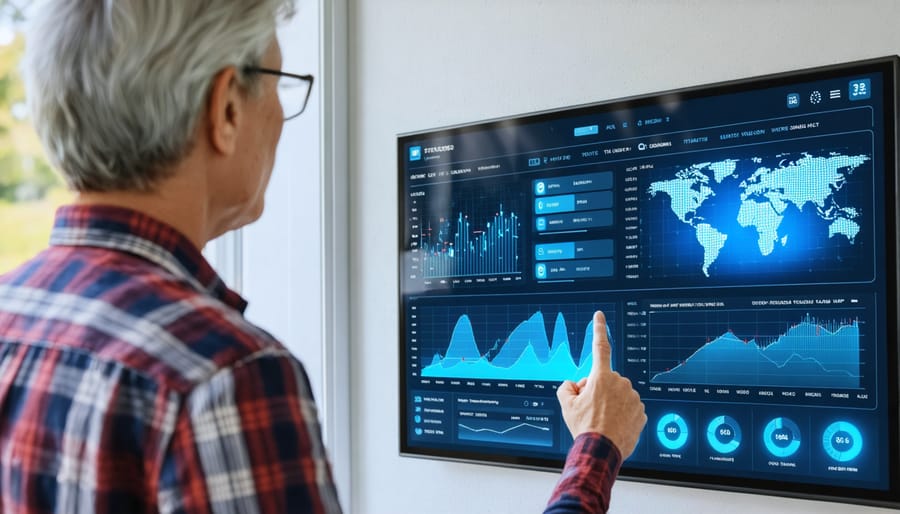
Real-World Success Stories
Meet Sarah and John Thompson from Colorado, who transformed their mountain cabin into a fully self-sufficient haven. Their 5kW solar system, complete with battery storage, powers their entire home year-round, even during heavy snow seasons. “We haven’t paid an electric bill in three years,” Sarah proudly shares, “and our system paid for itself faster than expected thanks to tax incentives.”
In rural Montana, the Martinez family installed a 7.5kW system with advanced lithium batteries to power their 2,000-square-foot farmhouse. Despite initial skepticism about winter performance, their system generates excess power during summer months, effectively balancing out the reduced winter production. “Our system hasn’t failed us once in four years,” reports Maria Martinez. “We even power our electric farm equipment.”
The Green Valley Eco-Community in Arizona showcases how multiple off-grid homes can thrive in desert conditions. Their fifteen households each run on individual 6kW systems, proving that solar independence is achievable even in extreme climates. The community reports average energy cost savings of $2,400 per household annually.
Perhaps most inspiring is the story of retired couple Bob and Linda Wilson in Maine, who converted their traditional home to off-grid solar at age 65. Their carefully sized 4kW system, combined with energy-efficient appliances and smart home technology, keeps them comfortable through New England winters. “People thought we were crazy to go off-grid at our age,” Linda remarks, “but it’s actually simplified our lives and reduced our monthly expenses significantly.”
These success stories share common elements: thorough planning, professional installation, and smart energy management practices. Each demonstrates that with proper sizing and setup, off-grid solar systems can reliably power homes across diverse climates and lifestyle needs.
Taking the step toward off-grid solar living is an empowering decision that offers multiple rewards. From achieving energy independence to reducing your environmental impact, a well-designed solar system can transform your home into a self-sustaining haven. By understanding the core components – from solar panels and batteries to inverters and charge controllers – you’re better equipped to make informed decisions about your system’s design.
Remember that successful off-grid living requires careful planning and consideration of your energy needs. Start by conducting a thorough energy audit, choosing quality components, and working with experienced professionals for system design and installation. While the initial investment may seem substantial, the long-term benefits of energy independence, reduced utility costs, and environmental stewardship make it a worthwhile endeavor.
Don’t let common misconceptions about off-grid solar deter you. Modern systems are more efficient, reliable, and user-friendly than ever before. With proper maintenance and monitoring, your solar system can provide decades of reliable power for your home.
Take the first step today by assessing your energy needs and consulting with solar professionals in your area. The path to energy independence starts with a single decision, and the sooner you begin, the sooner you’ll enjoy the benefits of sustainable, off-grid living.
Ready to embrace a more sustainable future? Your journey to energy independence awaits.

